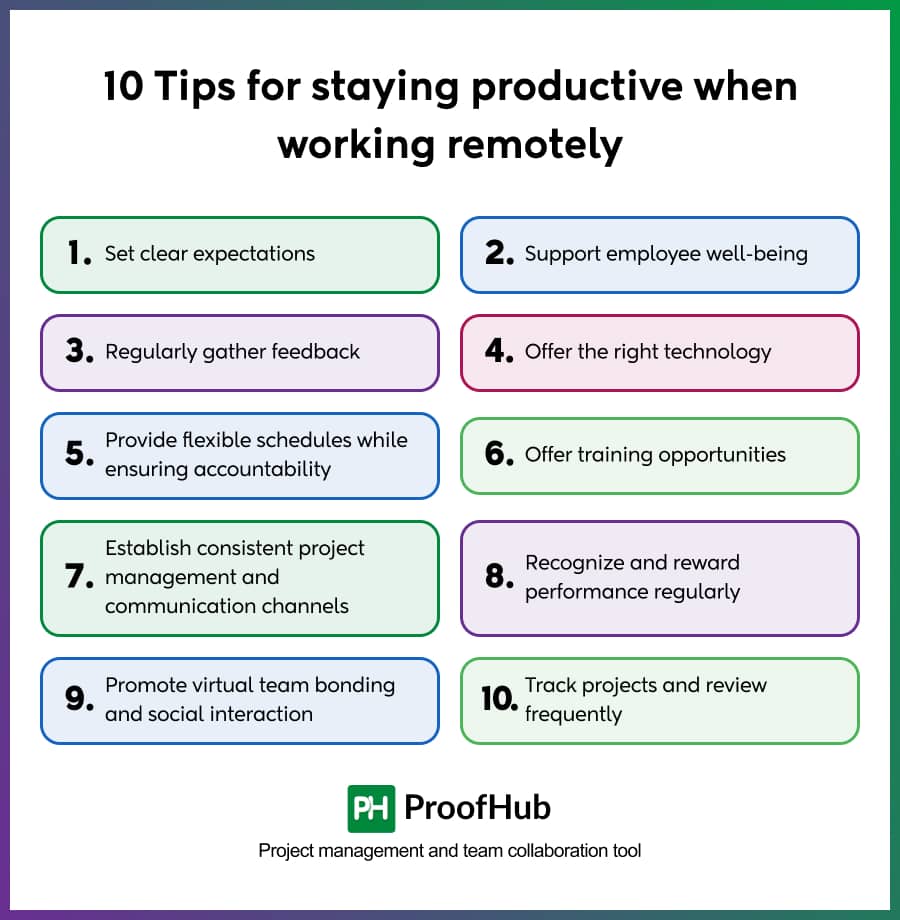The freedom and flexibility of remote work are undeniable, but for managers, they introduce a unique set of challenges. “Quick check-ins” can become constant interruptions, and the lack of visibility often leads to questions about actual productivity.
The core challenge is no longer oversight; it’s about fostering connection and accountability without the four walls of an office. Scattered communication and difficulty tracking progress can quickly hinder performance.
This article provides a manager’s guide to navigating these obstacles. We’ll share proven productivity tips to keep your team focused and demonstrate how tools like ProofHub can help you build stronger collaboration habits, ensuring your team stays aligned and delivers its best work, even when working remotely.
10 Tips for staying productive when working remotely
For a remote team manager, productivity isn’t about monitoring activity; it’s about curating outcomes. Your job is more than just assigning tasks. Your job role entails creating a conducive environment along with effective time management strategies to stay productive and focused.
These are 10 tips that can actually help managers improve the productivity of their remote team:

1. Set clear expectations
To boost the remote work productivity of your team, managers need to set clear expectations by defining roles, goals, and responsibilities. Along with it, you also need to provide necessary tools and support, and foster a culture of trust and open communication through regular feedback and check-ins. When you provide clear expectations, you can easily eliminate confusion and empower your remote employees towards shared goals.
According to a 2021 report on remote work, 34% of remote workers say that the transparency in roles and responsibilities creates a deep sense of connectedness at work.
Let’s understand it through an example!
A vague instruction like “work on the project proposal” can lead to days of misaligned effort. Instead, your goal is to create a system where everyone knows the what, the why, and the by when, empowering them to execute with confidence. Your employees will not know when to complete a project on priority if you don’t let them know that you need it. You need to set clear expectations while assigning them tasks.
How can you do it?
- Outline specific tasks and deliverables
- Break down bigger goals into small, manageable milestones
- Hold regular check-ins and discuss progress
- Promote a healthy workspace
- Be transparent by fostering a culture of collaboration
2. Support employee well-being and work–life balance
Supporting employee well-being isn’t just about being empathetic. It’s a direct driver of productivity and retention. To enhance the productivity of your remote team, you need to encourage balance and well-being of your team by protecting your employees’ personal time, promoting the use of breaks and vacation days, and providing access to support mental health and wellness resources. Such actions help reduce burnout, stress, and provide a healthy remote work environment, which leads to increased job satisfaction and high productivity.
How can you do it?
- Avoid sending emails after work hours
- Ensure your team is aware of the mental health resources provided by the company
- Arrange virtual workshops on stress management topics
- Create dedicated channels for non-work communication
- Establish clear guidelines for communication outside of work hours
3. Regularly gather feedback
Asking for feedback is one such thing that you should do to improve the productivity of your remote team. It is the simplest way to improve business discussions. You must maintain a weekly or monthly feedback system, which can give you an idea of what needs to be changed to achieve desired results effectively. Ask your team members what they are concentrating on for a certain period of time, how well they know their objectives, and assist them in resolving potential issues that may arise.
How can you do it?
- Regular 1:1 video calls for check-ins and discussing challenges
- Make dedicated feedback channels where employees can share their thoughts
- Acknowledge the feedback and take action
- Integrate feedback into performance reviews
- Hold meetings addressing what went well and what needs to be improved
4. Offer the right technology and resources for remote work
You can find a great number of tools online that facilitate the right technology for remote work. You ended up concentrating on the subject because remote work is expanding nowadays, and using these tools can help save time, achieve overall goals, and increase productivity.
How can you choose the right technology?
- Identify the problem first
- Match features to workflows
- Check the ease of use and adoption
- Assess the total cost of ownership
5. Provide flexible schedules while ensuring accountability
Trust your employees to be accountable enough to complete their work on time. This includes setting clear goals and objectives and trusting them to manage their own time, while providing the right tools and technologies. When you emphasize the importance of having boundaries between work and life, you can build a team connection that fosters a productive and remote environment.
How can you do it?
- Develop a formal policy outlining work hours and communication expectations.
- Encourage proactive communication, like regular check-ins
- Avoid micromanagement and empower your team to manage time
- Introduce a communication tool
Also read: How to hold employees accountable? (With actionable tips)
6. Offer training opportunities
Regular training opportunities for remote employees can easily fill the gaps in their skills, which leads to fewer errors. It also keeps employees engaged and reduces turnover in a remote setup. It also builds their confidence and gives a sense of autonomy in their work. When you invest in your employee’s skill improvement, you gain their trust that you care about them.
How can you do it?
- Review performance data and team feedback to identify which competencies need improvement
- Create individualized learning plans
- Host live virtual workshops
- Encourage peer-to-peer learning
- Offer short modules so employee can fit them in their daily routine
7. Establish consistent project management and communication channels
Providing your remote team with a structured project management and team communication channel is essential, as it fights miscommunication and isolation by giving clear protocols and a centralized place for everything. This strategy also helps managers prioritize the outcomes, build trust, and increase productivity by tracking how work is done and information is shared.
How can I do it?
- Define different communication channels and their purpose
- Create a communication policy to make it predictable and reduce confusion
- Establish core collaboration hours suitable for your globally distributed team
- Choose the right tool that offers project management and team collaboration software
8. Recognize and reward performance regularly
If you want to enhance the productivity of your remote team, you need to start recognizing and rewarding your team’s performance. You should start celebrating achievements, big or small, using both public and private methods. Acknowledge the hard work of your team members by demonstrating their impact on overall company goals. Consistent recognition enhances motivation, engagement, and a positive culture that encourages continued high performance.
How to reward employee performance?
- Highlight successes in team meetings or through internal communication channels
- Consider well-being perks, such as gym memberships or mental health resources
- Encourage team members to take breaks to avoid burnout
9. Promote virtual team bonding and social interaction
Foster team bonding and social interaction by holding regular virtual social events such as coffee breaks and games, encourage cross-functional collaboration, and provide opportunities for non-work-related discussions.
How to promote virtual team bonding?
- Create a dedicated, non-work-related chat for instant communication, weekend plan
- Start meeting with a personal check-in
- Invite team members to talk about their hobbies
- Organize virtual game nights
- Try to connect team members who are not in the same team
10. Track projects and review frequently
To improve the productivity of your remote team members, you must have a structured approach to project tracking and frequent outcome-based reviews. When you don’t have a physical office, you need to establish effective management practices to replace daily, in-person check-ins with a clear and reliable system for communication, transparency, and oversight.
When you prioritize enhanced visibility, early problem detection, and data-driven insights, you can easily create an effective and transparent workflow. This culture builds a culture of trust in the organization and ensures that the team remains motivated, focused, and on track to meet project goals.
How to do this?
- Set SMART goals
- Implement a routine for frequent reviews
- Foster a culture of transparency and feedback
Why is productivity important for teams working remotely?
Productivity is essential for remote teams to maintain efficiency, achieve organizational goals, and sustain productivity because it ensures work completion, encourages creativity, and permits more employee autonomy and focus.
However, without productivity, remote teams miss deadlines, give poor outcomes, and affect the business negatively. Productive remote teams have the mental space and time to innovate and explore new ideas, benefiting the entire organization.
What are the common challenges that affect productivity while working remotely?
While remote work has given a new level of flexibility and autonomy, it presents a unique set of challenges that can hamper productivity and employee well-being. Managers need to address these issues to ensure their team’s success.
1. Compromised collaboration
Collaboration is not always planned; it can happen anywhere, in the hallways, over a cup of coffee, or on a conference call. Remote workers often miss out on such organic moments, and the opportunity can be easily missed as they don’t know when the decisions are being made.
This lack of participation often results in frustration, delays, and wasted time. Over time, it can easily make employees feel isolated, disengaged, and less productive.
How to overcome?
Collaboration should be intentional. As a manager, you need to establish structured touchpoints where teams can sync regularly, stay informed, aligned, and engaged. Make sure you have a cross-functional “open office hours” where your employees can have impromptu discussions.
2. Lack of personal connection and interaction
Working remotely can make employees feel disconnected and detached from their peers, which undermines trust and team spirit. Without casual interactions, bonds weaken, and a sense of belonging fades, eventually impacting engagement and morale. This lack of connection can make employees less productive.
How to overcome?
Host regular virtual coffee breaks, team games, or informal check-ins to maintain a sense of community and belonging.
3. Low visibility or lack of recognition
In a remote setup, individual contributions can easily be overlooked, leaving employees feeling undervalued and demotivated. Without clear visibility, managers may struggle to assess performance, and high performers may lose motivation to maintain standards.
How to overcome?
Recognize wins publicly, whether in team meetings or chat channels, and give consistent feedback to highlight individual impact.
Read more: 25 Employee recognition ideas to appreciate your team’s hard work
4. Continuous distractions
In a remote setup, individual contributions can easily be overlooked, leaving employees feeling undervalued and demotivated. Without clear visibility, managers may struggle to assess performance, and high performers may lose motivation to maintain standards.
How to overcome it?
Encourage employees to create dedicated workspaces, set clear work–life boundaries, and use time-tracking features in tools like ProofHub to maintain accountability.
What tools improve productivity in remote work?
Choosing the right tools is crucial to keep your remote teams productive, organized, aligned, and efficient. ProofHub stands out as the most comprehensive solution. ProofHub centralizes files, tasks, feedback, and communication all in one single place, which eliminates the time that goes into switching multiple apps. Teams can easily plan projects, track progress, and collaborate in real-time without losing context. The key features include centralized workspace, built-in time tracking, real-time chat, online proofing, feedback, Gantt Charts with dependencies, and custom workflows and Kanban boards.
These features enable better time management, strengthen team alignment, and faster decision-making. With detailed reporting and analytics, you can get multiple project views. ProofHub scales easily as teams grow, making it an all-in-one productivity hub for remote work on a flat fee, no per-user fee.
Conclusion
Remote productivity isn’t about squeezing in longer hours; it’s about creating the right environment where people can do their best work without being in the same room. By applying these remote productivity tips, managers can help their teams stay focused, collaborative, and accountable.
When challenges such as poor visibility, scattered communication, or lack of connection are addressed proactively, remote work stops being a compromise and becomes a strength. The right mix of intentional leadership and the right technology not only boosts day-to-day output but also builds a culture of trust and innovation.

